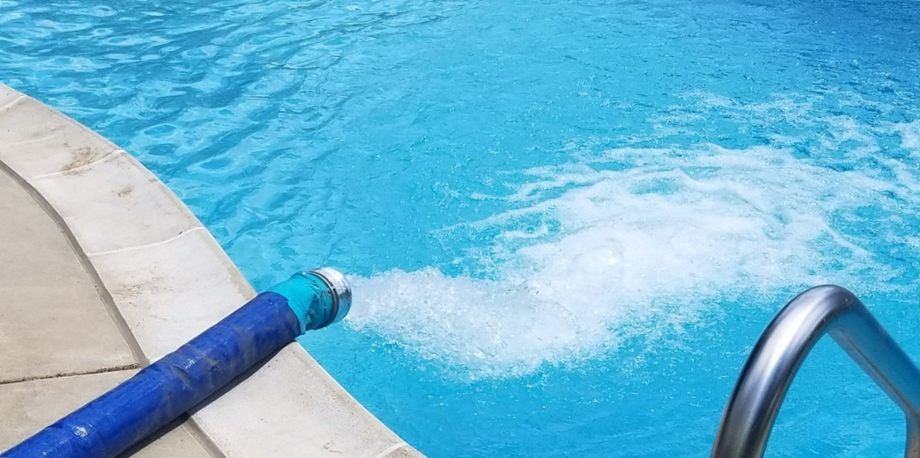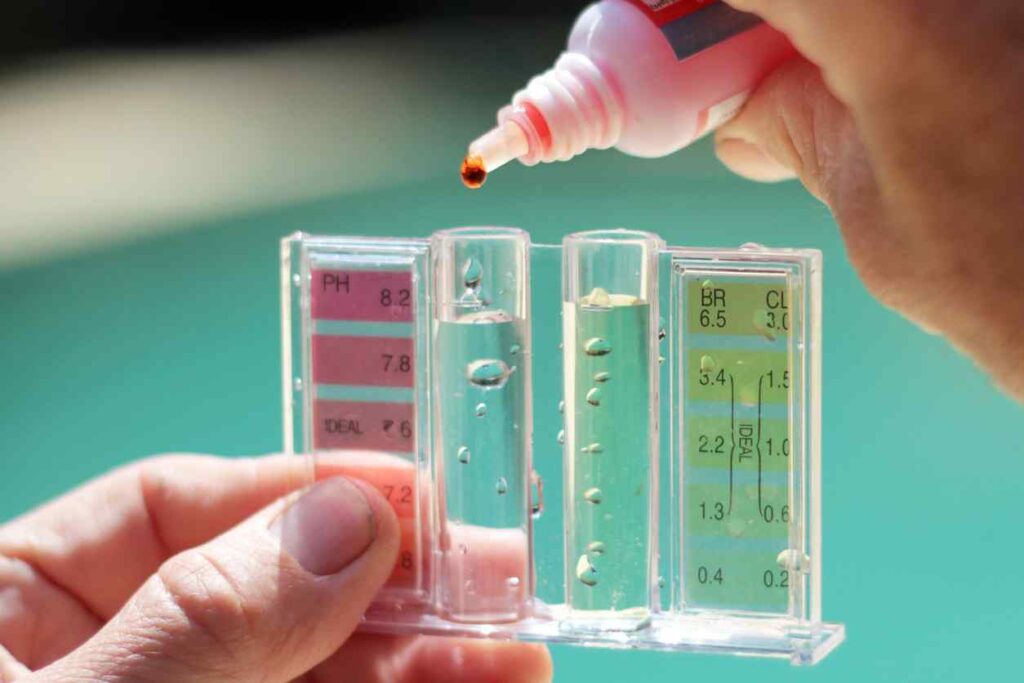
Adding Water and Chemicals to Your Opening Up Pool
Now is the fun part, getting your pool read to dive in (well if its warm enough of course)
- It’s likely that there is insufficient water in your pool to start your system and so you will be adding more. One way to save time is to run the garden hose into the pool before you remove the pool cover. This may save a day or 2 of filling now.
- Now you got all the equipment connected or soon will have you don’t want the pool water turn green. So, if the water level is still too low for the equipment to function, just add liquid chlorine to the pool water and then move it about using a telescopic pole and attached brush – broom. It’s not too effective but better than nothing. Don’t overdo the chlorine though. A little and a repeat each day is better.
- Water chemistry check is the next step once the pool water is at the correct level. It’s very likely your pool chemistry will be way out at start up so it’s important to bring up to spec quickly.
- Stabilizer: This is known as water conditioner, cyanic acid or stabilizer. It helps prevent the UV burning off the chlorine in your pool. To be effective needs to be in the range of 30 – 50 ppm.
- Total Alkalinity: always check this first and follow the alphabet in correcting aspects of pool water chemistry. Alkalinity first and should be 75 – 180 ppm.
- Calcium Hardness: is required in all pools to prevent the water either finding its own minerals by leaching from the pool surfaces or metallic components in the plumbing system or depositing mineral residues on the same. Ideally it needs to be kept with in the range of 200 – 300 ppm and in saltwater pools nearer the 200 – 220 mark to prevent scaling.
- Chlorine levels: as you know chlorine is the main sanitizer and so its levels need to be maintained within prescribed range to be really effective. 1 ppm of free chlorine (1 – 3 is ideal) and for total chlorine no more than 1 ppm above the free level. If more than 1 ppm you have combined chlorine or chloramines.
- pH: is the relationship between acid and alkali in your pool.Though if often of as being complex, there is only one basic thingyou need to keep in mind. The pH needs to remain close to neutral which is 7, and also close to the pH of your eyes (7.0 – 7.3) to save upsetting your eyes. So, keep it with 7.2 – 7.8 but much better to keep it within 7.3- 7.4, slightly alkali.
- Phosphate levels: This is something you may never have to worry about, as its largely the result of run off from golf courses or places where fertilizer has been used. You may also find if your pool has become the local duck pond also. By keeping the Chlorine levels 1 – 3 ppm you should not have an algae issue, however if it drops away and you have phosphates in your pool, it may start an algae garden. Levels over 500 ppb (parts per billion) then stat a treatment.
- Salt Levels: if your pool as a chlorine generator it means you have salt in your pool and this needs to be monitored for maximum effectiveness. Do test the salt level in the pool after the reopening in the spring and then determine how much slat is needed to bring it back to the required level. Use only pool salt or pure sodium chloride. Note that you want salt with the least amount of impurities in it and the maximum amount of sodium chloride. Impurities can damage the cell and also leave a white film over the pool surface, which is quite a nuisance. It is best to dissolve the salt in a 5 gal bucket (repeat as needed) and then tip into the pool. This saves the potential for discoloration on the pool floor from a large mass of undissolved salt.
- Langelier Saturation Index: Is a very useful unbiased calculation to determine if your pool water is aggressive/corrosive (low LSI < -0.3) balanced ( – 0.3 to + 0.3) or scale forming (high LSI >+0.3). Your pool shop can do this for you when you take in your water samples for testing. Ideally keep a record of the results and see the trends. If you follow these, you can prevent a deterioration in your pool water getting out hand and save money. So, if going from balanced and slowly increasing, you will start to see scale forming. But you can prevent that by adding the right chemicals to prevent it happening. Your pool shop can guide you.

